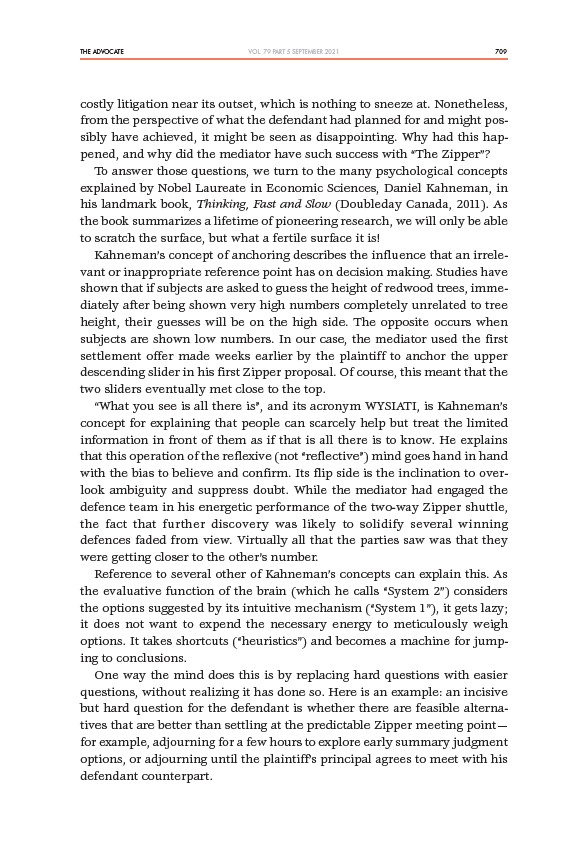
THE ADVOCATE 709
VOL. 79 PART 5 SEPTEMBER 2021
costly litigation near its outset, which is nothing to sneeze at. Nonetheless,
from the perspective of what the defendant had planned for and might possibly
have achieved, it might be seen as disappointing. Why had this happened,
and why did the mediator have such success with “The Zipper”?
To answer those questions, we turn to the many psychological concepts
explained by Nobel Laureate in Economic Sciences, Daniel Kahneman, in
his landmark book, Thinking, Fast and Slow (Doubleday Canada, 2011). As
the book summarizes a lifetime of pioneering research, we will only be able
to scratch the surface, but what a fertile surface it is!
Kahneman’s concept of anchoring describes the influence that an irrelevant
or inappropriate reference point has on decision making. Studies have
shown that if subjects are asked to guess the height of redwood trees, immediately
after being shown very high numbers completely unrelated to tree
height, their guesses will be on the high side. The opposite occurs when
subjects are shown low numbers. In our case, the mediator used the first
settlement offer made weeks earlier by the plaintiff to anchor the upper
descending slider in his first Zipper proposal. Of course, this meant that the
two sliders eventually met close to the top.
“What you see is all there is”, and its acronym WYSIATI, is Kahneman’s
concept for explaining that people can scarcely help but treat the limited
information in front of them as if that is all there is to know. He explains
that this operation of the reflexive (not “reflective”) mind goes hand in hand
with the bias to believe and confirm. Its flip side is the inclination to overlook
ambiguity and suppress doubt. While the mediator had engaged the
defence team in his energetic performance of the two-way Zipper shuttle,
the fact that further discovery was likely to solidify several winning
defences faded from view. Virtually all that the parties saw was that they
were getting closer to the other’s number.
Reference to several other of Kahneman’s concepts can explain this. As
the evaluative function of the brain (which he calls “System 2”) considers
the options suggested by its intuitive mechanism (“System 1”), it gets lazy;
it does not want to expend the necessary energy to meticulously weigh
options. It takes shortcuts (“heuristics”) and becomes a machine for jumping
to conclusions.
One way the mind does this is by replacing hard questions with easier
questions, without realizing it has done so. Here is an example: an incisive
but hard question for the defendant is whether there are feasible alternatives
that are better than settling at the predictable Zipper meeting point—
for example, adjourning for a few hours to explore early summary judgment
options, or adjourning until the plaintiff’s principal agrees to meet with his
defendant counterpart.